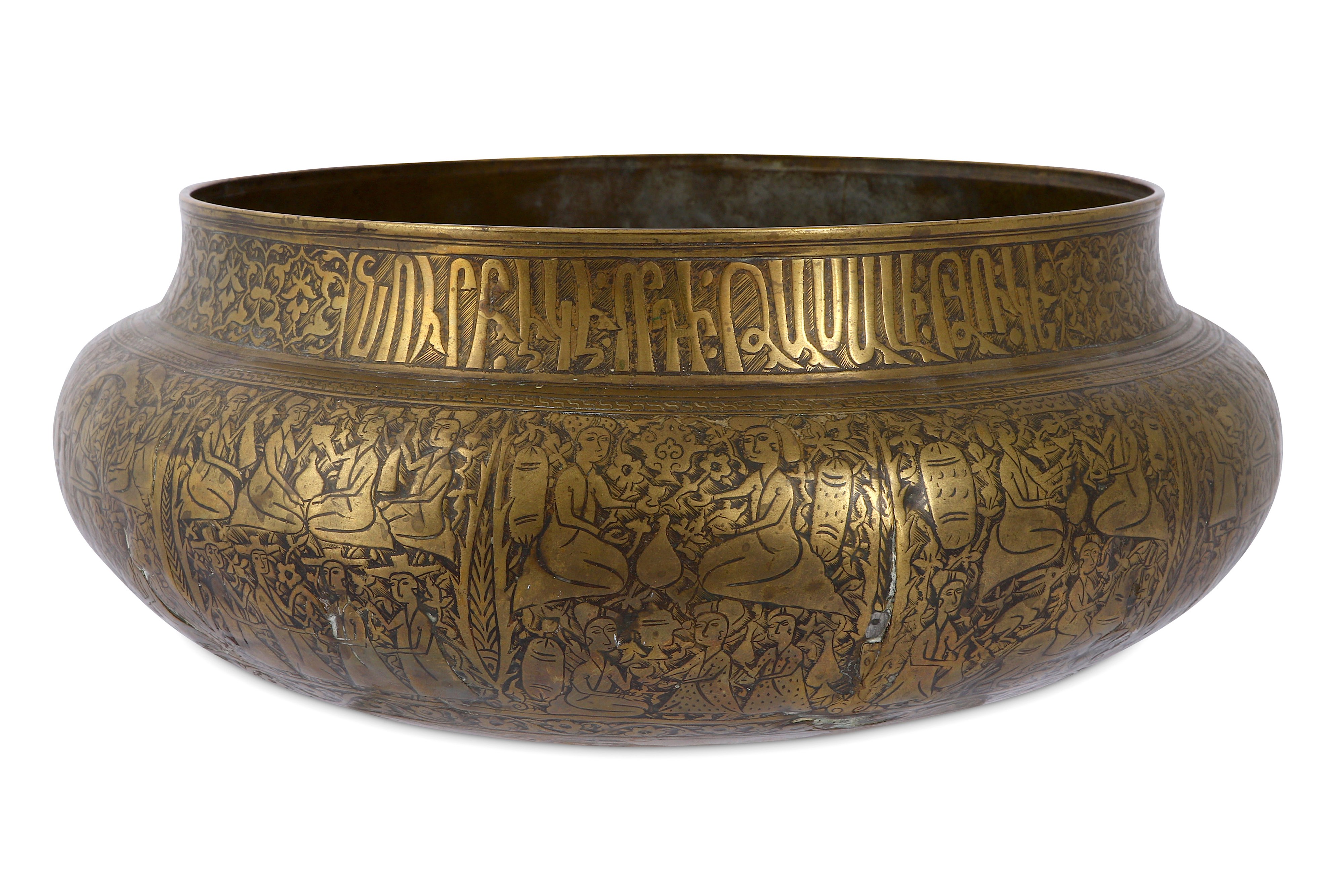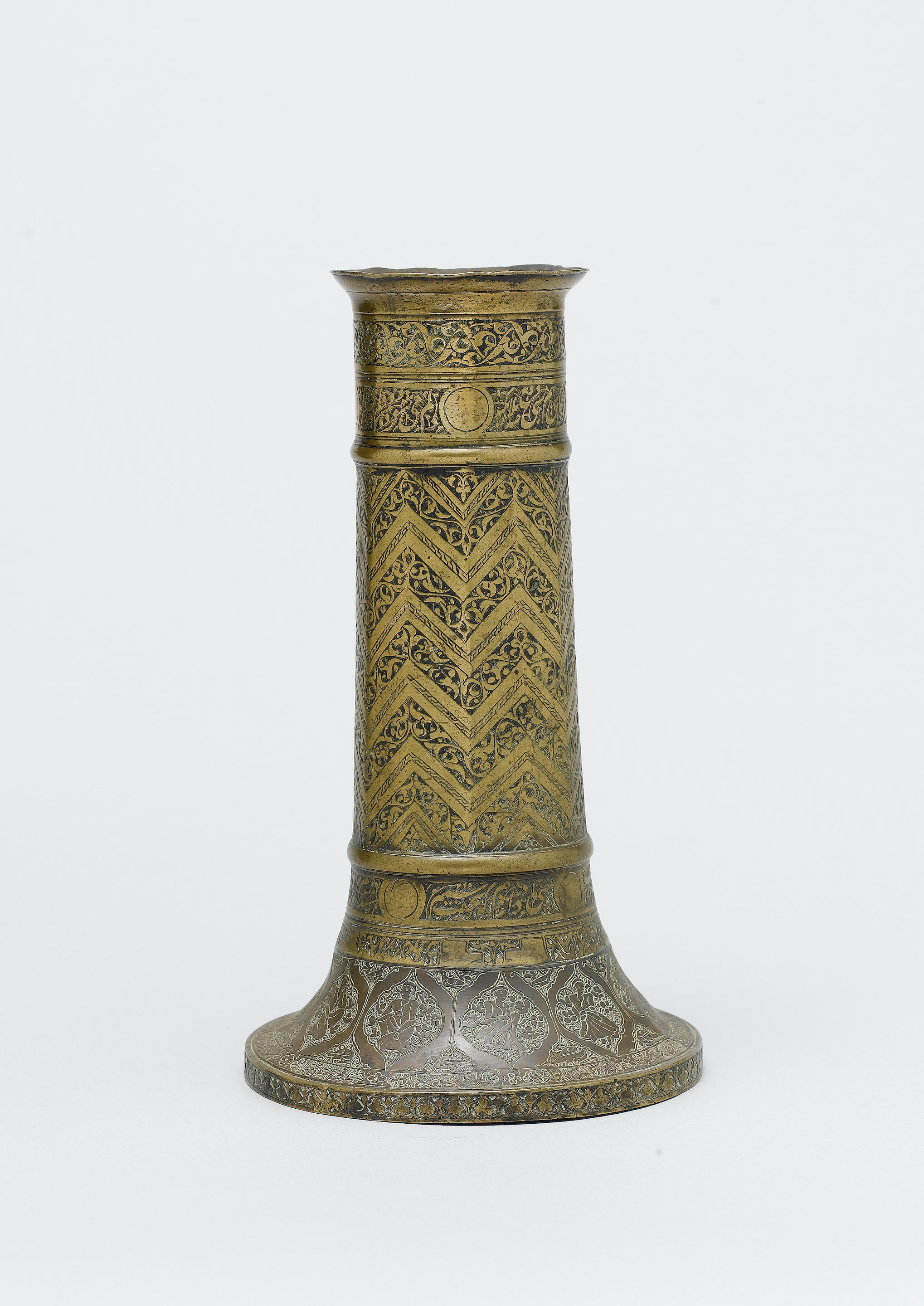A SAFAVID BRASS TORCH-STAND (MASH 'AL) WITH ARMENIAN INSCRIPTION Western Iran, late 16th - early 17th century Of cylindrical shape, resting on a gently splayed base, rising to a reinforced everted rim decorated in reserve with an Armenian ownership inscription, the body finely engraved and decorated with recurrent Safavid metalwork motifs such as split and full palmette scrolls, arabesques, stylised flowerheads and chevron design, the neck with a central calligraphic nasta'liq band grouped in four polylobed cartouches, three hemistiches from the Bustan of Sa'di and the fourth hemistich from the Diwan of Ahli Torshizi, also known as Ahli Khorasani, framed within two vegetal scroll bands, the central body chamfered in zig-zag cuttings interspersed with floral scrolls, the flared foot with three concentric decorative bands repeating the same motifs, 31.5cm high. Provenance: from the private collection of James and Ana Melikian. Inscription: Endranos (?) to son of Mnatsakan and to them Exhibited and published: Beauty and Belief: Crossing Bridges with the Arts of Islamic Culture, Brigham Young University Museum of Art (February – September 2012) and Indianapolis Museum of Art (November 2012 – January 2013), p. 196. Persian mash'al / masha'el, also known as pillar candlesticks, became very prominent during the reign of the Safavid ruler Shah Tahmasp (r. 1524 - 1576). Their Golden Age, however, can be witnessed during the reign of Shah Abbas I (r. 1588 - 1629), when a stronger rhythm and emphasis on their architectural form is added. The decorative patterns peculiar to this period, and present on our mash'al as well, are chevrons, lozenges, a variety of spiralling / scrolling vegetal and floral tendrils, lobed medallions and the typical escutcheon-shaped pendants, often around the base (A. S. Melikian-Chirvani, Islamic Metalwork from the Iranian World 8th-18th centuries, London, 1982, p. 264). Our candlestick shares several features with another one published in the same book (cat. 139, p. 311) and dated to the late 16th century, leading to suggest a similar dating for ours. Two more torch-stands with analogous features to ours, one highly polished, the latter unpolished, successfully sold in the UK auction market at Sotheby's London, 5 October 2011, lot 258 and at Lyon & Turnbull Edinburgh, 22 October 2013, lot 7. However, differently from ours, they did not present an Armenian ownership inscription, possibly connecting our lot to the Armenian community of New Julfa, Isfahan.
A SAFAVID BRASS TORCH-STAND (MASH 'AL) WITH ARMENIAN INSCRIPTION Western Iran, late 16th - early 17th century Of cylindrical shape, resting on a gently splayed base, rising to a reinforced everted rim decorated in reserve with an Armenian ownership inscription, the body finely engraved and decorated with recurrent Safavid metalwork motifs such as split and full palmette scrolls, arabesques, stylised flowerheads and chevron design, the neck with a central calligraphic nasta'liq band grouped in four polylobed cartouches, three hemistiches from the Bustan of Sa'di and the fourth hemistich from the Diwan of Ahli Torshizi, also known as Ahli Khorasani, framed within two vegetal scroll bands, the central body chamfered in zig-zag cuttings interspersed with floral scrolls, the flared foot with three concentric decorative bands repeating the same motifs, 31.5cm high. Provenance: from the private collection of James and Ana Melikian. Inscription: Endranos (?) to son of Mnatsakan and to them Exhibited and published: Beauty and Belief: Crossing Bridges with the Arts of Islamic Culture, Brigham Young University Museum of Art (February – September 2012) and Indianapolis Museum of Art (November 2012 – January 2013), p. 196. Persian mash'al / masha'el, also known as pillar candlesticks, became very prominent during the reign of the Safavid ruler Shah Tahmasp (r. 1524 - 1576). Their Golden Age, however, can be witnessed during the reign of Shah Abbas I (r. 1588 - 1629), when a stronger rhythm and emphasis on their architectural form is added. The decorative patterns peculiar to this period, and present on our mash'al as well, are chevrons, lozenges, a variety of spiralling / scrolling vegetal and floral tendrils, lobed medallions and the typical escutcheon-shaped pendants, often around the base (A. S. Melikian-Chirvani, Islamic Metalwork from the Iranian World 8th-18th centuries, London, 1982, p. 264). Our candlestick shares several features with another one published in the same book (cat. 139, p. 311) and dated to the late 16th century, leading to suggest a similar dating for ours. Two more torch-stands with analogous features to ours, one highly polished, the latter unpolished, successfully sold in the UK auction market at Sotheby's London, 5 October 2011, lot 258 and at Lyon & Turnbull Edinburgh, 22 October 2013, lot 7. However, differently from ours, they did not present an Armenian ownership inscription, possibly connecting our lot to the Armenian community of New Julfa, Isfahan.




.jpg)
.jpg?w=400?width=1600&quality=70)
.jpg)
.jpg)



.jpg)



Testen Sie LotSearch und seine Premium-Features 7 Tage - ohne Kosten!
Lassen Sie sich automatisch über neue Objekte in kommenden Auktionen benachrichtigen.
Suchauftrag anlegen